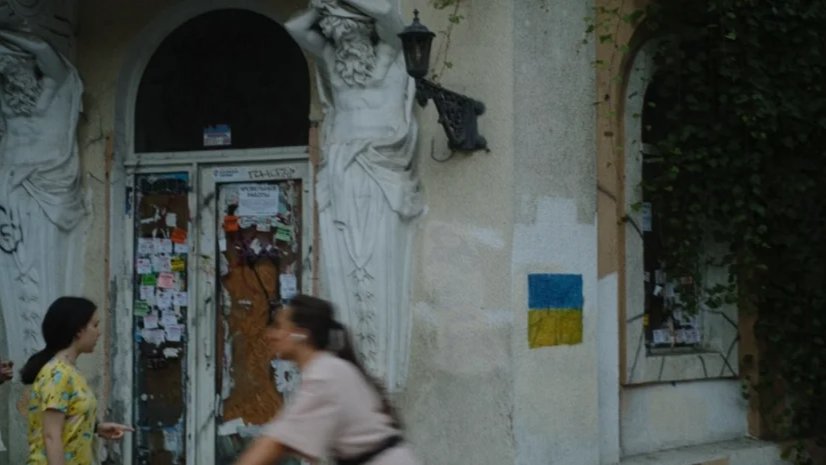Grain means port, port means city. This sentence encapsulates the role of grain flows in Odesa’s history, starting from the times when the city was still named Khadjibey. It is much harder to describe the conditions in which Ukraine finds itself while breaking through the naval blockade in Odesa and going back to exporting grain.
The air raid warning goes off while I’m sitting in a coffee shop, under an umbrella. It wails piercingly. A strict male voice reminds citizens: “Civilians, the audio signal ending does not mean that the danger has passed! Stay hidden!” A pause follows, and then the silence is filled with normal noises once again: spoon clicking against a teacup on the table nearby, tires screeching, someone playing the violin, a toddler crying. A well-groomed pug starts racing towards an independent cat. There is a couple kissing under a black banner with the writing on it that says Freedom Not Death (a campaign of local artists in support of captured Azovstal steelworks fighters).
The entrance to the Duke of Richelieu Monument and the Potemkin Stairs is closed: restricted area. The beaches are officially closed: there is danger of mines. Storefronts and windows of historic buildings located in the centre of the city have been boarded up to protect from attacks or, in some cases, in the aftermath of the attacks. There are flags hanging on buildings, balconies, flagpoles near shops, restaurants, and banks. Blue-yellow rectangles are drawn on walls and gates. There is a flag of Ukraine placed even near the bronze François Sainte de Wollant that stands near the pedestal of the monument to Catherine the Great.
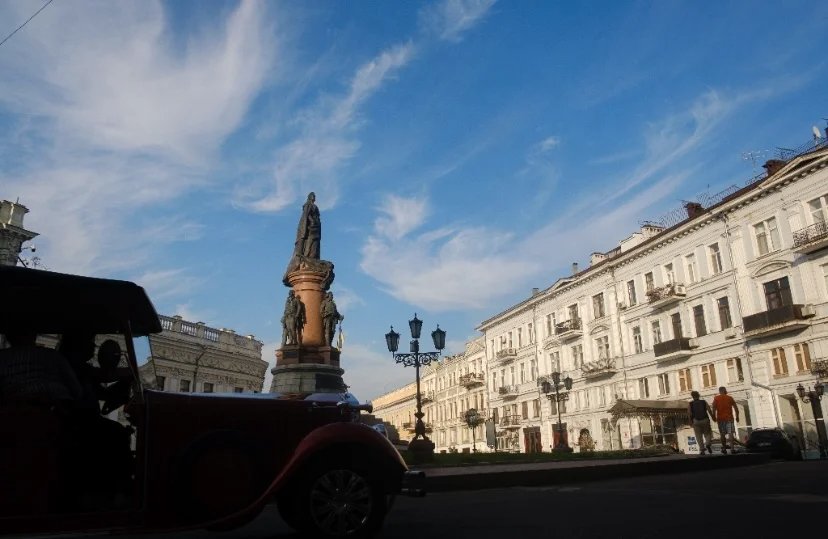
Photo: George Ivanchenko / exclusively for Novaya Gazeta. Europe
There are similarities to my time in Tel Aviv in summer 2006, during the war with the Lebanese Hezbollah. Back then, the northern cities, Haifa and Nahariya, were damaged more than any other. Tel Aviv was not under attack, life continued there as normal: the offices were open, families with kids were walking down the embankment, the music was playing. The only reminders of war were the big number of both flags and military patrols. When I tried to complain to my Israeli colleague, — how are they relaxing when, at this moment, their compatriots could be dying? — he reacted calmly and said: “We are always ready.” And translated the Hebrew phrase that was featured on graffiti around the city which I had seen just as often as the flags: “Alive with Israel.”
It is obvious: Odesa feels out of place this summer holiday season. But at least during the day, it keeps up appearances — more likely, for its own equilibrium than for tourists. There are not many of them, but they are present.
At night, when the curfew is enforced, the sirens seem louder. In addition, church bells also sound the alarms at night time.
The fears of the recent past awaken once again: the deadly strikes by the Russians came from the sea, which has historically always fed the city.
Ship queues and information fortresses
The document signed on 22 July in Istanbul — the grain export agreement, the goal of which is to facilitate the export of Ukraine’s grain to the world market, evoked different reactions. The mediators — the Turkish president and, especially, the UN secretary general — triumphed. The organisation was at last able to prove its efficiency. Russia was satisfied. The Russian Defence Ministry won the right to control the process, to tell the city and the world how much Ukrainian corn, vegetable oil, flour, and soy were allowed to sail freely, with the next step, potentially, being the West having to soften the sanctions. Ukraine got an opportunity to sell old stock and free warehouses for the new harvest. And only the residents of Odesa ended up having to choose between personal safety and big business interests, despite the fact that no one had asked them for their opinion.
Social media was on fire. Such arguments as “the Moskva cruiser with the S-300 missiles on board sank and won’t resurface, while the Snake Island, occupiers’ ex-base in the north-western part of the Black Sea, was returned to Ukrainian jurisdiction” did not quite help to convince anyone. “And if we demine the port approaches, and then they attack!” the worried city residents said. Who would be brave enough to swear that an escalation of the situation was impossible?
On 23 July, the next day, the Kalibr missiles struck the Odesa commercial port, thus confirming that the residents’ fears had not been unfounded. Two Russian missiles, according to the operational command South, were struck down by air defence, while another two hit a pump station. A fire erupted. The shockwave reached the buildings near the port. Neither people nor the granary were damaged. But Ukraine’s plans to start the grain export the next day fell through. Foreign shipowners were not prepared to take a risk for the purpose of, and here I am quoting the UN, “alleviating the suffering of millions starving people around the world”.
Only the Danube ports Reni and Izmail (located in the Odesa region — translator’s note) worked on export. Their capacity and throughputs were always on the lesser side, especially, if you compare them to those of the “Big Odesa”. Now, there were queues of ships. This [export] pause lasted up until 1 August. By that date, the seaports Odesa, Yuzhnye, and Chornomorsk had become fortresses protected informationally.
“A totally centralised story,” said Oleh Muratov, deputy head of the Odesa region military administration, upon seeing my list of questions. He proposed I redirect them to Ukraine’s Ministry of Infrastructure. It has to be noted that the ministry does regularly update its website: the volume of stock transported, how much stock is left in the warehouses, which ship departed and where to, which ship arrived for loading. Government publications also cover this topic. However, the presence of journalists during any step of the operation is impossible. The only exceptions are made for the times when Zelensky or high-level foreign guests, like Antonio Guterres, visit the seaports.
Being a reporter and having realised that I lacked important information, I got caught up in a psychological trap during my time in Odesa. Was I supposed to insist, continue digging, look for loopholes, look for specialists that would agree to anonymously tell me more than what is allowed by law, i.e. the wartime law?
The experts I managed to talk to all admitted that they were mostly basing their comments on experience and assumptions rather than facts.
Their assessment touched upon such topics as: the quality of the grain stored on bulk carriers since the beginning of winter; the conditions for formation of the queues to leave the seaport; competition between several multinational grain trader companies; who owns the 20 million tonnes of grain stocked in the warehouses. According to Ukraine’s Minister of Agrarian Policy and Food Mykola Solskyi, during the period from 24 February to the opening of the sea corridors, 1.25 million tonnes of grain were awaiting their fate stored on bulk carriers.
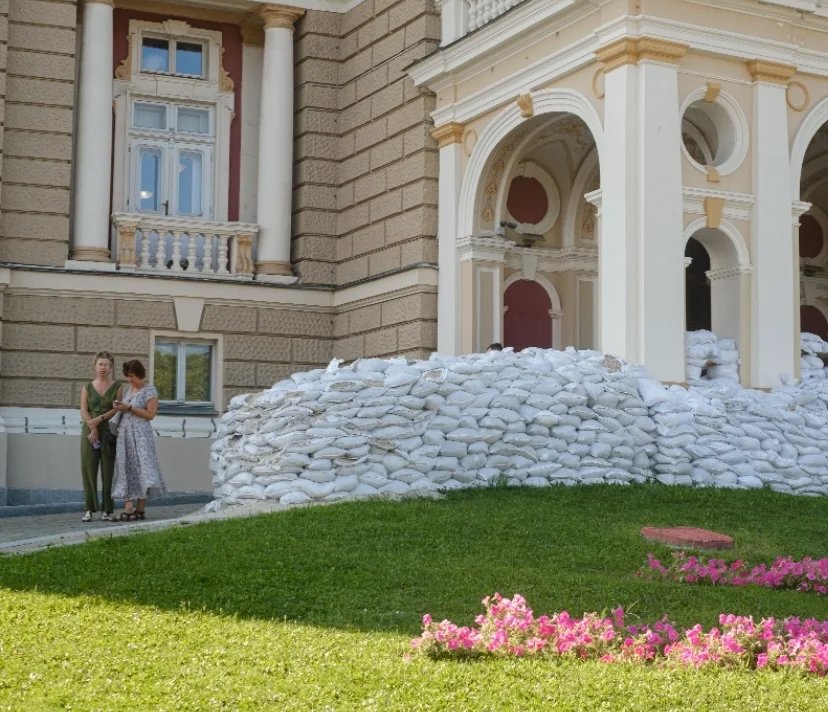
Photo: George Ivanchenko / exclusively for Novaya Gazeta. Europe
‘Grain corridors are not a show’
Nataliya Gumenyuk, chief of the joint coordination press service of the Defence Forces of Ukraine’s south, agreed to speak with me about ensuring the safety of the transportation process, though she did add: “only about what’s allowed and in general terms!”
First of all, I recall the discussion about the idea of military escorts for the “carriers”. Was this idea implemented?
“No comment,” Nataliya shut me down.
Ok. Then please comment on what you can.
The security is guaranteed by international partners. The escorts — I’m not specifying which kind — are guaranteed by the UN and Turkey.
Do these guarantees only exist on paper or will they be materialised in case of a threat…
I can’t comment. They exist, that’s enough. Seaports are some of the main strategic objects of Ukraine, the [security] regime there is of the highest level.
There’s a lot of personnel in the ports. You can’t assign a police agent to every freight forwarder. Everyone’s got families, friends, acquaintances. So, there’s quite a wide range of people aware of the ins and outs… Are you able to control the situation completely?
We are aware of the threats we are facing. We understand that the human factor can’t be completely ruled out. Certain activities are conducted with the seaport’s employees. They sign liability documents; they have restricted access to information. Even the assigned police agent is a person too. As a journalist, you must know that information can leak through personal messages — about missile threats, for example, etc. So, we can’t exclude the possibility of leaks; the information front is a battlefield, which we are trying to regulate.
At the end of our conversation, Gumenyuk emphasised:
“There has to be an understanding that the work of grain corridors is not a show, it’s an exit from a difficult economic situation of both our country and the world. It shouldn’t be made into a PR project, there just needs to be an opportunity for the seaports to be able to work, for soldiers to be able to ensure safety, and for nations that need bread to receive grain.”
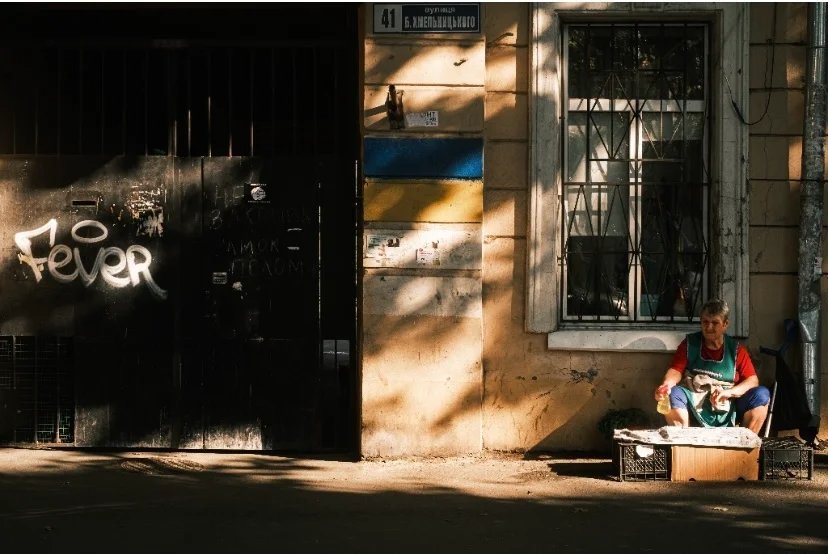
Photo: George Ivanchenko / exclusively for Novaya Gazeta. Europe
First corn transportation attempt
On 29 July, G7 ambassadors arrived in Odesa to demonstrate that there is nothing to be scared of in the city and to remind Russia that the grain agreement has to be respected. On 1 August, after consultations with Ukraine’s Armed Forces and the Joint Grain Coordination Centre in Istanbul, the task of which is to monitor the transportation of grain, had concluded, bulk carrier RAZONI left the Odesa commercial port and sailed towards the Tripoli port. The ship under the flag of Sierra-Leone with 26,000 tonnes of grain on board was the first grain carrier to leave that port after five months of forced inactivity.
However, the customer refused to accept the cargo, citing “the contract terms being violated”. The shipper rushed on to search for new customers, Ukraine’s Embassy in Lebanon reported. The Marine Traffic service tracked RAZONI’s movements in real time, which was covered by Financial Times’s story on the ship’s route.
On 9 August, the ship docked at the port of Turkey’s Mersin, where it unloaded 1,500 tonnes of corn (Novaya Gazeta. Europe has previously covered the Turkish ports buying stolen Ukrainian grain from Russia — Olga Musafirova). Later on, the bulk carrier sailed on towards Egypt. Near the north-western Cyprus coastline, the ship turned off its transponder. According to Planet Labs satellite images, on 14 August, the ship docked at the Syrian port Tartus. Which is where the Russian military base is located.
Food and grain trades with Syria are not prohibited by Western sanctions imposed on the Damascus regime because of the civil war. Still, the first grain transportation attempt was neither a failure nor a victory for the hungry that the UN was expecting. (The UN had promised financial guarantees to the ships that would collaborate with the World Food Programme, which would be buying the grain. At the end of July, the UN held tenders to purchase grain for African countries.) RAZONI’s corn had nothing to do with helping the starving. As it later turned out, it was intended to be chicken food.
Bread on its way to somewhere
On 8 August, the seaport Yuzhnye let out the first vessel — SAKURA. SAKURA was on its way to Italy and joined up with the bulk carrier ARIZONA that had left the port Chornomorsk and had been sailing towards Turkey. The ship caravan was transporting about 60 tonnes of agricultural products. On the same day, the bulker FULMAR S entered the Chornomorsk port to be loaded for the first time since the start of the war.
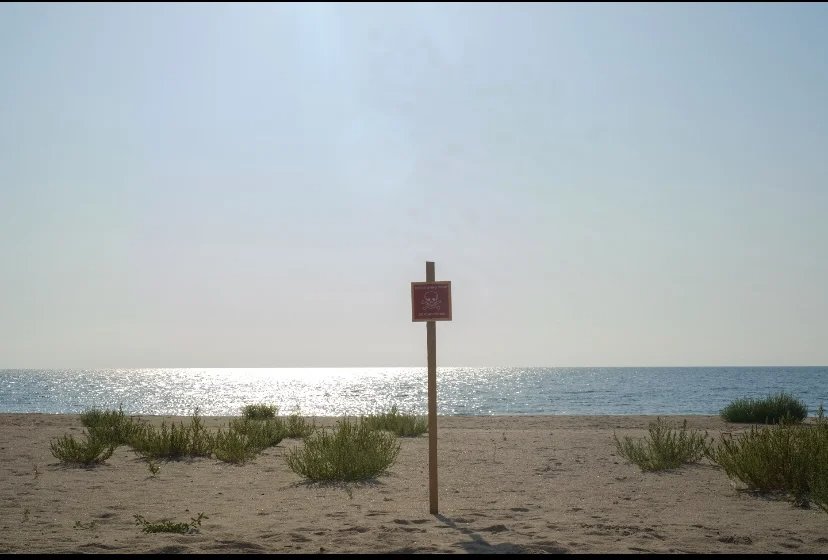
Photo: George Ivanchenko / exclusively for Novaya Gazeta. Europe
On 9 August, the Turkish port Derince was awaiting Ukrainian grain delivered from Chornomorsk by a Turkish vessel POLARNET. That news was shared by the Ukrainian affiliate of the multinational agricultural company Kernel. POLARNET had been standing empty in the port since 24 February, but the shipowner readily agreed to Kernel’s proposal so that the ship did not end up in ballast. Judging by the publications on specialised resources such as Latifundist and Elevatorist, Ukraine’s Ministry of Infrastructure thought that the first vessels to be used would be the vessels of Ukrainian agribusiness companies. It was thought that the multinationals had decided to wait the situation out. In reality, it turned out that the only ones prepared to take risks at that time were traders like Kernel, Kargill, Bunge — seeing as they were the only suppliers of foreign exchange earnings into the country. Especially considering that one of the biggest grain terminals in Ukraine — Neptune located in the Yuzhnye port — belonged to the American corporation Kargill.
The New York Times analysed all the open source data available for the first week of August and concluded that
the vessels that had left the Odesa ports after being stuck there for months were not eager to sail towards Yemen, Somali, Ethiopia, and Kenya, countries whose populations were facing catastrophic levels of hunger.
The ships were on their way to Turkey, England, Ireland, Italy, China — to the places assigned by the grain buyers.
Several days later, the first humanitarian vessel departed. On 14 August, cargo ship BRAVE COMMANDER carrying 23,000 tonnes of wheat left the Yuzhnye port. It was chartered by WFP for a cargo delivery to Ethiopia. As of now, WFP purchased 30,000 tonnes of Ukrainian grain for countries-victims of the global food crisis. The remaining 7,000 tonnes would be sent to those in need soon, promised WFP.
In his interview with Forbes.us, Agrarian Policy and Food Minister of Ukraine Mykola Solskyi expressed hope that, in the case that the corridors continued to function consistently, Ukraine would be able to export around 18 million tonnes of last year’s harvest before it went bad. “If everything goes well, then we will reach the levels of 4-5 million tonnes of total export per month in September. We are expecting to go back to the pre-war capacity of the ‘Big Odesa’ seaports — around 3.5 million tonnes a month,” he clarified.
According to the ministry’s estimates, the country will harvest 65-57 million tonnes of grain, 50 million of which will be exported. The rest of the grain is for domestic demand. I will add myself that the harvest has already been collected in the Odesa region. Combine harvesters are on their way from the central regions of the country to the northern ones. Meanwhile, grain elevators, partially purposefully destroyed by Russian missiles, partially not yet liberated of the “carryover balances”, are soon to be filled up with the new harvest…
Interview in a church
Serhiy Bratchuk sets a meeting with me and our photographer at the Cathedral of the Nativity, one of the oldest churches in the city. He says he feels at home here.

Serhiy Bratchuk. Photo: George Ivanchenko / exclusively for Novaya Gazeta. Europe
“When the war ends, I will ask for a blessing to be ordained to the rank of deacon. I’ll think about the rank of priest. I’ll ask them when we win,” he tells us.
As of now, the church has collected enough donations to buy two drones for the Ukrainian army. Serhiy has another meeting with his brothers in arms here at the church right after our interview: they will receive another gift.
Before the war, Serhiy Bratchuk was known as the leader of the Information Resistance group. Now, the war veteran appears so often on national TV commenting on the situation in Odesa and its surroundings, that we do not even feel right saying that he is doing this job as a volunteer.
“They started attacking the city on 24 February, at five in the morning. At six, I was already in the former regional conscription office building.
We agreed with the self-defence guys in advance: if there’s a war, we meet there, but we agreed on 8 a.m. There were a lot of people there, it was clear they were at a loss what to do.
I went into the corner and started shooting an impromptu video on my phone. I explained what’s going on and posted it online, “Serhiy recalls the start of his “career” as a spokesman for the Odesa military administration.” The headquarters told me: ‘Now you’ll be the voice of military announcements! You’ll inform people about any attacks and threats.’”
At first, Bratchuk was presented as the speaker of the Odesa diocese, his real job, and as the head of the Odesa military administration’s public council. "To create a certain public image,” he explains. Serhiy notes that he is often in contact with army officers on the issue of “grain corridors”, so he has reason to say that there is a clearly determined route for the ships.
“When they were preparing it, they consulted experts of the Ukrainian Navy, hydrographers and many others. No one was planning on opening the sea gates, or ports, to endanger Odesa. We cannot allow that. We haven’t been fighting this war for nothing since February. Only specially appointed pilots know who passes through the channel, where and how, to make sure that they don’t stray left or right and don’t get into… ‘trouble’. Ukrainian pilots are responsible for our part of the route, in our territorial waters. Then, other specialists lead the caravans.”
And if, God forbid, there is an enemy ship in the way?
Then the Black Sea will turn into the Dead Sea for them! We have firearms that will help us do the job if the enemy tries to meddle. Russian Telegram channels say that Bratchuk keeps scaring the population with a potential landing of troops. What is there to be scared of? We eliminated the first landing of troops on 26 February. But we didn’t know how to report on that to tell the truth and to avoid overexciting the locals. It was our first local victory! But right now, I am warning people: there is still a risk of landing. Unfortunately, Russia’s Black Sea Fleet has the upper hand…
Serhiy continues:
Thank God for Turkey! Even though there are some specific problems… well, I don’t want to start an international scandal! (He smiles) Turkey closed off the Bosporus Strait back on 1 March for all military vessels. There were five of them there, with Kalibrs [missiles] on board. Can you imagine what would happen if they were right here on our doorstep, in the Black Sea, instead of the Mediterranean Sea? Now, the aviation is becoming more active. The air raid warnings in Odesa are happening because of that. I don’t think they will dare shoot. The Russians used to complain: we are giving them guarantees, but for some reason, Ukraine doesn’t want to demine its waters, it doesn’t let the ships through! Russians have their own interest in the “corridors”.
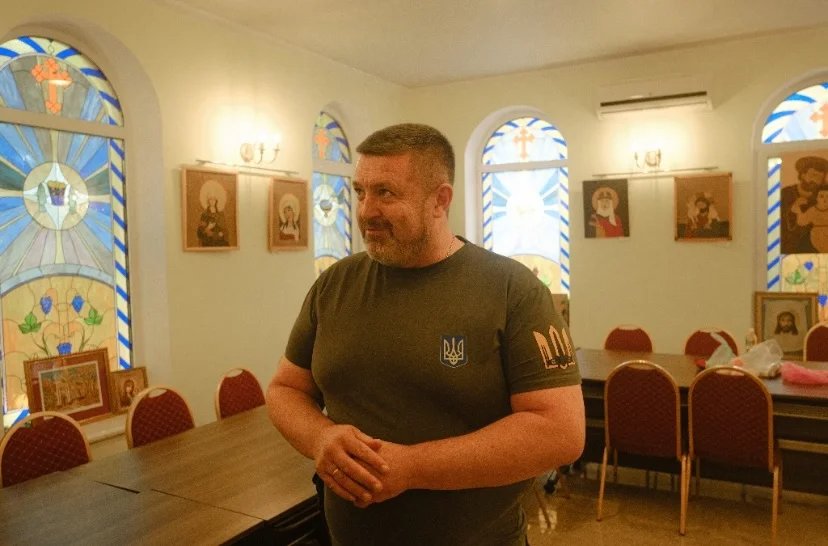
Photo: George Ivanchenko / exclusively for Novaya Gazeta. Europe
Shouldn’t the grain caravans be escorted, protected against provocations?
Right before we launched the route, two Turkish frigates came in. They are monitoring the traffic. Russian ships have moved closer to Crimea. Although we shouldn’t forget that there are submarines in the Black Sea, also loaded with Kalibrs. But there are fewer missiles on submarines than on ships, four pieces each. We need to keep a close eye on that.
Bratchuk reminds us that since 24 February, 17 bulk carriers, mostly from countries with a soft tax climate, have ended up "stuck" Odesa. The crews have become hostages of the situation, and Russia is to blame for that. He agrees that those who work at the port are under close scrutiny from the FSB and their agents. He drums his fingers on the table:
"But our three weeks of experience have mostly been positive".
What do the draymen have to do with it?
"Do you know why all the draymen stood up when Kostya entered the bar?" Serhiy Dibrov asks us. He answers his own question:
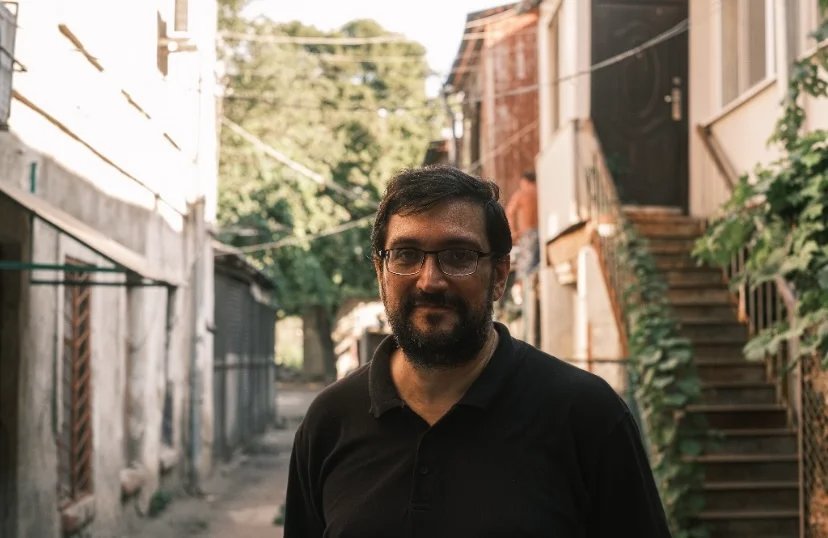
Serhiy Dibrov. Photo: George Ivanchenko / exclusively for Novaya Gazeta. Europe
"He’s a fisherman, and he hasn’t come back to Odesa empty-handed. He brough three to four tonnes of mullets on his barge. There are no fridges, he needs to sell the fish quick. Kostya goes to the bar to hire the movers. ‘There’s work to do!’ And everyone stands up to offer their services. Kostya is a respected, reliable and generous client, you can do business with him."
Who are the draymen? They drive small wagons, usually pulled by two horses. Their wagons fit the Odesa streets and can carry up to 1.5 tonnes of cargo. It would take them about two or three trips to unload Kostya’s barge. But their main source of income is transporting grain from the barns on the outskirts of the city to the port for loading.
The draymen are not simple workers, they can safely be considered middle class, similar to today’s truckers who have their own trucks. In one trip, they can transport about 1.5 tonnes of cargo. It is a serious and rather profitable business. Jewish draymen had their own synagogue. There was a lot of competition and monopoly conspiracies. By the way, the Odesa pogroms were not just based on religion and nationality, some of them were caused by economic factors, like redistribution of the market.
I notice some tourists who strayed away from their group to join us. It seems to be more interesting here. National Guard officers standing guard near the mayor’s office and the Seaside Boulevard seem to be listening to us, as well. The entry to the boulevard is cordoned off with police tape that warns: "Photo and video footage are forbidden!». It is clear why. There is a view on the entire port from the boulevard. This is how it was designed. Dibrov continues:
“The Seaside Boulevard was like our Wall Street. There were offices of European grain companies there. It was very convenient: you could see which ship had arrived and how the loading and unloading went right from your office window. Do you see that building over there, with the statue of Mercury, the god of commerce, and Ceres, the goddess of fertility, on top? It used to be a commodity exchange; this is where the deals were made. Now, it houses the Odesa City Council. People are saying: they used to sell stuff there and they still do. I don’t believe it, of course…
We all burst into laughter.
We got very lucky to have Serhiy Dibrov, a famous investigative reporter born and raised in Odesa, as our tour guide. His investigations often cause a stir in political, legal of medical circles. He studied to be an engineer, and still considers himself a novice reporter: he started in 2013. He has a lot of experience in other professions that he applies in his work today: at one time, he headed a fumigant company. His employees combated grain pests in warehouses, disinfected wagons and containers, eliminated insects before sending the cargo overseas. Dibrov knows how everything works from the inside, so our tour of Odesa had a special theme.
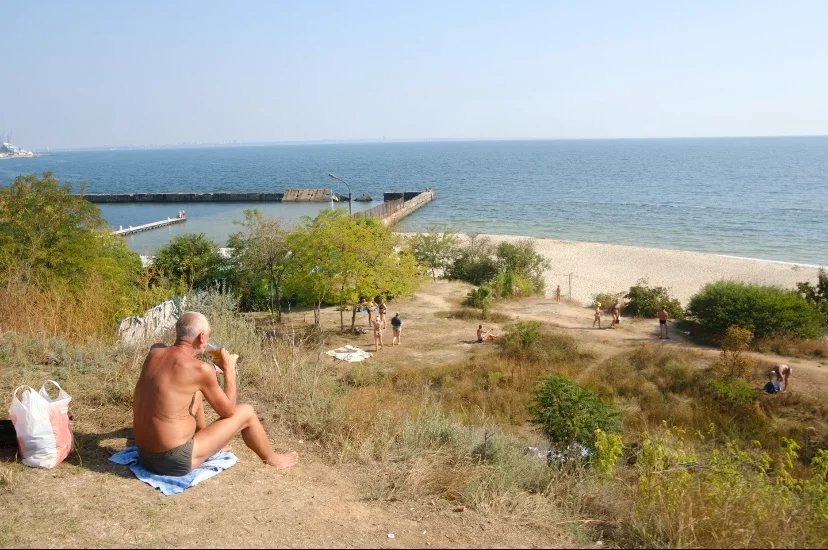
Photo: George Ivanchenko / exclusively for Novaya Gazeta. Europe
An air raid warning in ‘little Paris’
We walk along the long-gone ditches that used to serve as borders of the “free city”, Porto Franco, which now remains only in the city’s street names: Old Porto Franco Street, Miller Street, Haven Street, and, of course, the Bread Haven. To this day, there is a port elevator there, where grain is unloaded.
The grain cultivated in the steppes near the Black Sea became the main exported good of Porto Franco at the start of the nineteenth century. Its harvests and sales grew with each year. Foreign merchants did not come to Odesa empty-handed, and the import fees collected in the port filled up the city budget, making Odesa the fastest-growing and developing city in the world in the first half of the century.

Photo: George Ivanchenko / exclusively for Novaya Gazeta. Europe
The first general plan of Odesa was developed by François de Wollant with a pedantry and a love for correct proportions and the “golden ratio” inherent to Masons, he designed the city streets intersecting at a straight angle and introduced building restrictions. De Wollant’s ideas on organising the central part of the city have remained in the current general plan of Odesa developed in 2015.
Dibrov is confident that two hundred years ago, Odesa got very lucky. Firstly, in the years after it formed part of the Russian Empire, the city was ruled by European noblemen: José de Ribas, duc de Richelieu, Louis Alexandre Andrault de Langeron. Secondly, the Porto Franco status helped finance the “Odesa economic miracle”.
“De Richelieu, who was kicked out of France after the revolution, said himself that he would build ‘a little Paris’ here, taking into account the city building experience and the issues of the French capital. This is why Odesa, with its wide streets paved with Italian stone, did not resemble other Russian cities neither in its architecture nor spirit,” Serhiy says.
We hear another air raid warning. The imperial love towards the “Pearl of the Sea” does not come in conflict with Russia’s desire to destroy as many Odesa residents and the fruits of their labour as possible.
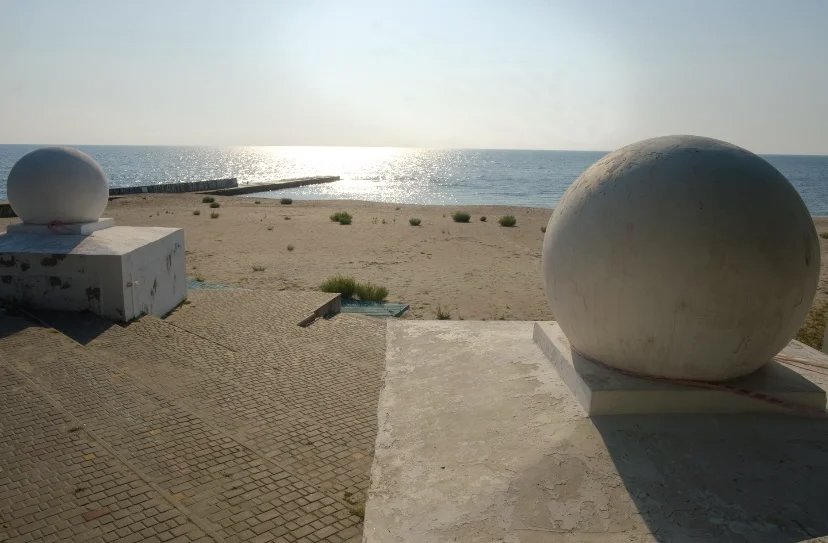
Photo: George Ivanchenko / exclusively for Novaya Gazeta. Europe
The major players are on Ukraine’s side
On the way to Serhiy’s home district of Moldavanka, the folklore home of the draymen (“I saw the last ones in the seventies!”), we talk about the modern agricultural business in Odesa.
“The grain business has always been a complicated one, it was closed-off and under strict control of all kinds of officials,” Dibrov says. “It was always hard to achieve anything without a ‘greased hand’. Under Yanukovych, all the ‘greased hands’ were controlled by one person, and ten years ago, it nearly led to the demise of the entire sector. Now, the situation is different. Some have contacts in the prosecutor’s office, some have patrons in the environmental service, some have connections in seaport administrations. I wouldn’t call that competition. It’s more akin to pluralism, which leaves room for manoeuvre and work.”
According to Dibrov,
“The agrarian sector is being globalised both in form and content, like it happens everywhere. Major traders gradually take over the entire production chain:
they invest in the purchase of land and equipment, in agricultural producers, in transportation, grain warehouses, stevedoring companies that do the unloading. As a rule, these are the firms with major Western capital. However, there are some Ukrainian ones, too, like Nibulon. (Novaya Gazeta. Europe recently reported on the tragic death of Nibulon CEO Oleksiy Vadaturskyi, who was killed in a targeted strike on his house in Mykolaiv — О. М.) We can have different opinions about what’s going on. But we see the results: over the last few years, Ukraine’s agricultural production has grown steadily.
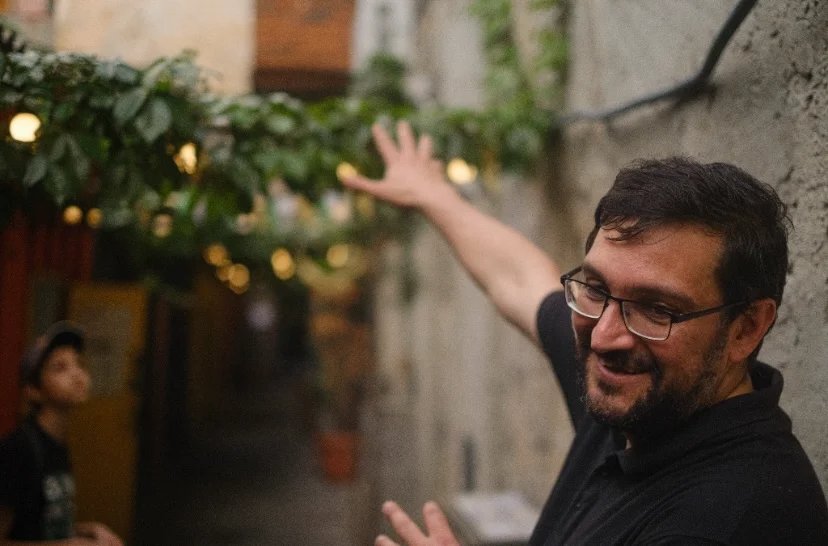
Serhiy Dibrov. Photo: George Ivanchenko / exclusively for Novaya Gazeta. Europe
“The grain that is now being transported from Ukrainian ports is mainly owned by major traders with Western or offshore capital,” Dibrov explains. “But this is a major part of Ukraine’s economy, too. The state has to take care of them as well and to look for a balance between economic interests and political factors. For example, they need to take into account what page of the document on export renewal will be signed by a Ukrainian representative and which will be signed by a Russian one. Yes, major grain traders are one of the main beneficiaries of export renewal, and they can put their own weight on the scale they chose.
Objectively, they should be on the side of Ukraine?
Of course.
Are they contributing to the fight against Russia?
The very existence of international financial and industrial groups interested in sowing, collecting and selling their produce here in Ukraine, especially in the long-term, counts as support already. The traders realise: if Russia arrives, they will likely sow and collect produce on the fields, but they won’t be the one to profit off it anymore. By the way, as a state, Ukraine doesn’t really benefit from the grain “corridors”. We don’t have export fees on grain, and port fees, pilot services, caravan escort services, and taxes on the wages of port workers do not amount to much, as a whole. And we need to pay back the VAT. But! Grain export is the end result of a huge production chain, starting with ploughing the soil and purchasing seeds and ending with selling the grain to Tunisia, for example. Breaking this blockade means that the entire system that employs millions of people will be able to go back to its normal conveyor mode. It can be seen as a victory for the Ukrainian economy.
“And the burnt fields, the destroyed elevators, the produce stolen from occupied territories, the threat of Ukraine losing its export partners and buyers — all this makes big business want to kick the assailants so hard in the head that they won’t be able to get back up,” I add.
The enemy will get nothing from Odesa
The story of Andrey Stavnitser, a 40-year-old Ukrainian businessman born in Odesa, co-owner and CEO of major terminal operator TIS, is an example of the famed Odesa tenacity. In March, the Russians took a liking to his new mansion in the village of Berezivka near Kyiv. They set up camp there to strike the Ukrainian capital from missile launchers, but they forgot to disable one of the owner’s security cameras. Stavnitser, who was abroad at the time, saw everything: the brave soldiers piled up everything they had stolen from the locals — TVs, laptops, iPads — inside the house. In the garden, they parked 12 units of military equipment, including multiple launch rocket systems Tornado-G and Grads. The millionaire contacted the Ukrainian army and gave them the exact coordinates of his house. He directed the attack on his own house until the uninvited guests were done for.
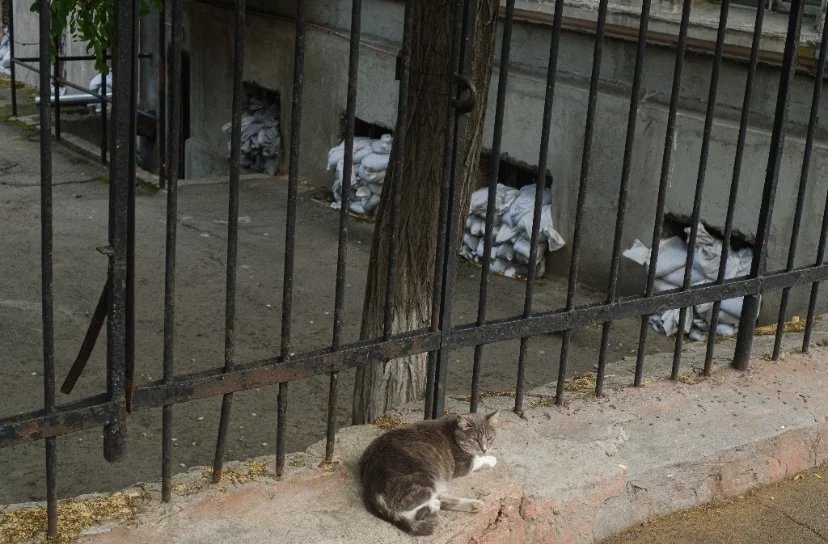
Serhiy Dibrov. Photo: George Ivanchenko / exclusively for Novaya Gazeta. Europe
“I felt disgusted. I felt dirty,” he told Good Morning Britain. “So, it was like an obvious decision. I want to do everything possible to help Ukraine win, because I think we’re safeguarding Europe’s safety. It is important for us to kick those bastards out of our land. It’s just a little piece that I could do. And I did it.”
We took a while walking along the streets of Odesa’s Moldavanka district, designed to fit two draymen’s wagons at once. A lot has changed since his youth. Now, all the gates have combination locks. Finally, we manage to enter a typical garden adorned with grapevines and roses climbing over the terraces where the locals dried their laundry. It smelt like fried fish there.
“The flats are in the form of a square. And there, in the middle…” Dibrov points to the line of buildings that could be used as garages or storage sheds. “There used to be stables. The draymen kept their horses and wagons there.”
“What are you shooting over there?! Did I give you permission?!” we heard a booming female voice from the terrace. There is a war on, we could get into trouble if someone suspects us of being a sabotage group.
The local woman confirmed it, too: the enemy will get nothing from Odesa.
P.S.
When the article was ready, we got a new report from the Ukrainian Sea Ports Authority.
According to official information, in the 26 days of the grain corridor’s work, 44 vessels exported over 1 mln tonnes of agricultural produce from Ukrainian ports to 15 countries of the world. The latest batch left the port on the morning of 26 August: 4 vessels left the Chornomorsk port. They will deliver 133,000 tonnes of grain, corn, and vegetable oil to the ports of Sudan, India, Egypt and Turkey. Last week (22-28 August), the ports of Odesa took in 13 vessels for loading. This amounts to 362,000 tonnes of grain, corn, barley, rapeseed, soya, and vegetable oil, which will be sent to the ports of Spain, Israel, Germany and Turkey.
Делайте «Новую» вместе с нами!
В России введена военная цензура. Независимая журналистика под запретом. В этих условиях делать расследования из России и о России становится не просто сложнее, но и опаснее. Но мы продолжаем работу, потому что знаем, что наши читатели остаются свободными людьми. «Новая газета Европа» отчитывается только перед вами и зависит только от вас. Помогите нам оставаться антидотом от диктатуры — поддержите нас деньгами.
Нажимая кнопку «Поддержать», вы соглашаетесь с правилами обработки персональных данных.
Если вы захотите отписаться от регулярного пожертвования, напишите нам на почту: [email protected]
Если вы находитесь в России или имеете российское гражданство и собираетесь посещать страну, законы запрещают вам делать пожертвования «Новой-Европа».
